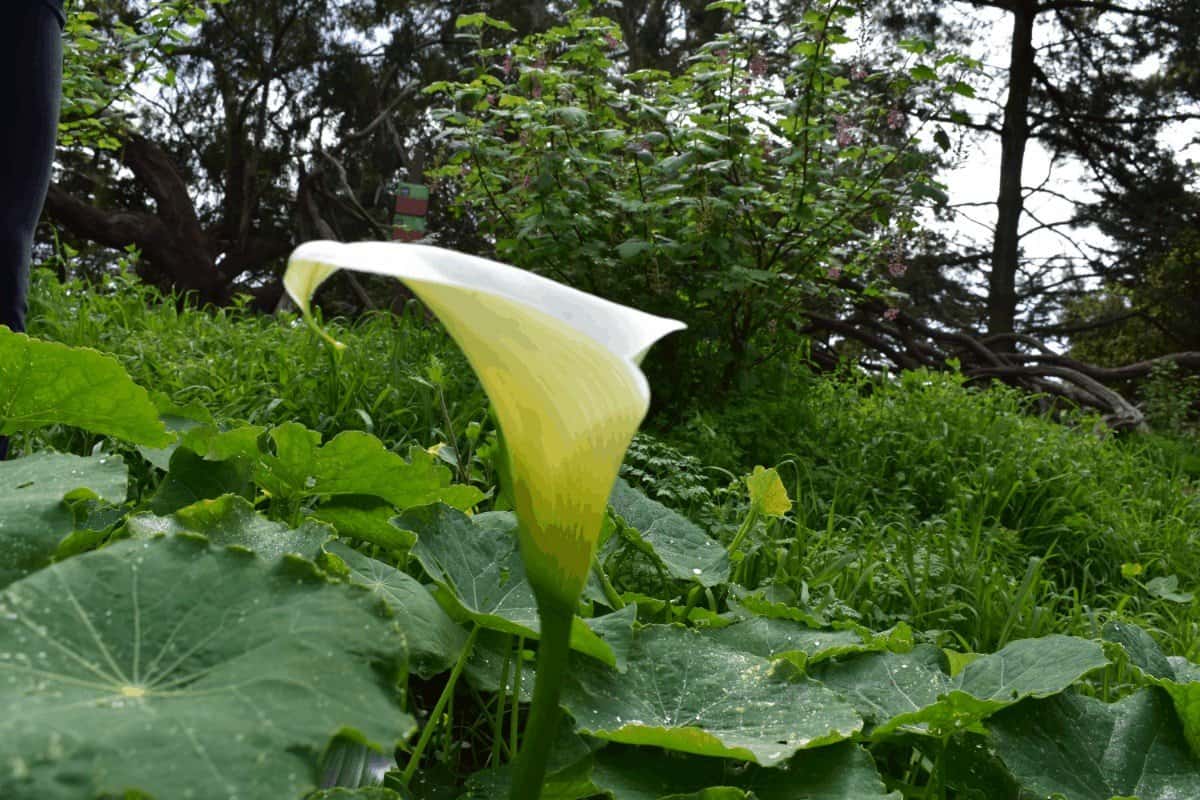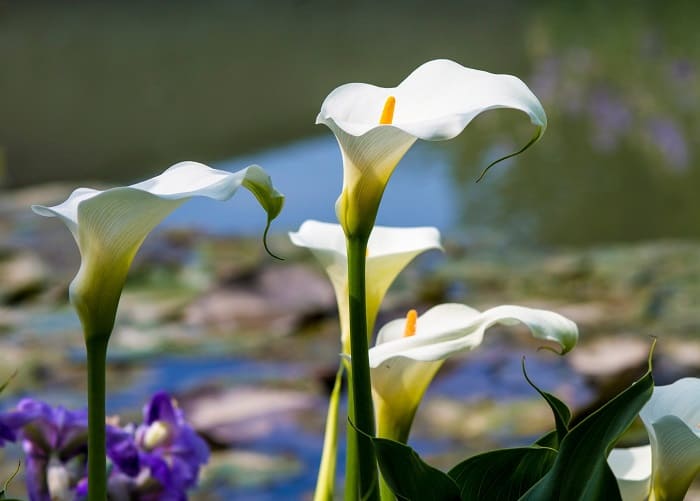Last Updated on December 28, 2021 by
The Cala Lily is native to South Africa and finds its habitats in the Marshy swamps of the African nation. It isn’t typically a lily but displays some qualities of the lily family. For the records, a Swedish botanist erroneously cataloged it as a lily in the 18th century and since then, it’s been referred to as a lily plant.
It’s a beautiful flower and comes in a variety of colors which include fuschia, yellow, red, cream, orange, and pink. It’s a perennial flower. It can be grown indoors or outdoors in your garden. Away from color variety, they differ in terms of temperature tolerance. Some are classified under the hardy temperate zones and some under the tender temperate zones. This article is comprehensive and will show you how to cater for both temperature variants.
It’s, however, a toxic plant if you mistake it for an edible. Do not let the graceful appearance trick you into thinking it’s edible. Taking care of this flower might be tasking since it’s very delicate and could die off if you slacken in tending to its needs which are quite demanding.
How to Care for these Beautiful Flowers Called Cala Lilies
Care is everything if you are dealing with plants. Once you’ve sowed the seeds into the soil or you bought them in a container half matured, care is utmost and would determine how the plant will look like in the days to come. You can take care of your precious Cala lilies in the following ways;
Sufficient Moisture
Your Cala lilies are natives to swamps, this means their nature is one that deserves consistent moisture. Make them thirsty and you risk their existence. Water consistently and you know the thumb rule with watering- water but don’t drown the plants. They need moisture to survive but too much of it can compromise the same survival they are looking for. When watering, you can tell how consistent you need to be with it by carrying out a test. The test goes like this: after planting or acquisition in a container, water it very well and observe for at least a week, after which you can check the soil for moisture depth of about one inch. After checking, if the soil is still dry then you should water more often if the opposite is the case, then you should water slowly.
Fertilize Them
The best way to fertilize this plant which as you’ll soon realize will save you valuable time is to mix the water you intend moisturizing the plant alongside a liquid fertilizer. So you see how you can do two jobs at the same time efficiently. However, you should not include the liquid fertilizer each time you decide to water the plant. Fertilizing is different from watering. Watering is required by the plant often but fertilizing should be done bi-weekly and in most cases, fertilizing is almost seasonal. For the callas, fertilize while they are flourishing in summer and spring. Repeat the process once or twice a month in autumn. Once the Cala lilies begin to bloom, quit the fertilization and watch as things unfold.
In fall, you should mulch them with garden compost or manure. This will protect them from weeds.
Watch for the Climate change
Autumn is when Callas prefer to thrive luxuriantly. At this season, their temperatures should be limited within 50 to 60F. When they start growing rapidly, they demand warmer temperatures but when they start flowering, you can introduce a partial shade to them. The rule here for survival when it comes to temperatures is to pick the variant of the Cala lily that is suited for the kind of temperature around your region. If you live in warmer regions, pick the variety that is suited for it and so it goes for colder regions. By doing this, you’ll be saving yourself all of the stress that demands you to keep up with regulating temperatures for your plant so that it does not get killed by extreme cold or set ablazed by the hot weather.
Trim Them
This should be the easiest way of attending to your Cala lilies. Trimming gives way for more blooming and production of beautiful flowers. That’s common knowledge. Here you trim by just cutting off the yellow leaves and some of the blossoms that have faded. Remove the flower stems after the blossoms have faded. It should be noted that stems are best cut closer to their tube roots. You should do this with your fingernails or use a sterilized pruning shear. They don’t demand consistent pruning like watering, just do so when you notice faded blooms and the yellow leaves. Always wear gloves when attending to the Cala lilies, they are highly toxic regardless of their alluring look.
Pest and Disease Control
The Cala lilies aren’t prone to disease infection and pest attacks. This doesn’t mean you should not be wary of this entirely. Most times your environment can be plagued with pest and that would affect every vegetation around it. Pest and disease control should be taken seriously. Fungal infection can’t be ruled out in Cala lilies. They could infect the plant at its rhizome which can cause it to rot. You can tell if it’s infected when you see the leaf margins growing yellowish or brownish. The leaves are very feeble and so they receive the highest impact of any attack on the plant. The leaves will begin to fall off with time. When you water the Cala lily beyond what is necessary, you create consistent moisture for fungal to breed. Constant water in a plant breeds bacteria and fungi. Avoid watering it too much, use the test to know how often you should water. Remember to also sterilize pruning shears before using them on the plant. They could be infected and have it transferred to the plant. If your callas are infected with fungi, a fungicide spray would solve the problem or you could call on an expert in the field for a lasting solution.
Conclusion
Cala lilies demand care and attention. All that beauty needs to be attended to and that’s what you should never relent in doing. Their leaves won’t die off if you touch them contrary to some beliefs. However, you should be conscious that they contain oxalic acid and wear gloves when attending to them. Also, keep the Cala lilies away from kids and pets as much as you can.
FAQs
Do calla lilies come back year after year?
Calla lilies are a perennial flower, which means that they come back in the same spot year after year. They are native to central and southern Africa and grow wild in many parts of the world including Europe, North America, Australia, and New Zealand.
Are calla lilies indoor or outdoor plants?
This plant can be indoor or outdoor and may need special care to thrive in both environments.
Calla lilies are generally an indoor plant that thrives indoors without the disturbance of natural sunlight.
Calla lilies thrive indoors without the disturbance of natural sunlight and even need less water than other plants. They are also considered to be pest-free and less prone to diseases.
How do you keep calla lilies blooming?
Calla lilies are very sensitive to the type of care they need. The following are some tips for keeping them blooming:
- Keep the soil moist by sprinkling water every day.
- Give the calla lily its own space, like a pot, with drainage holes so that it doesn't drown in its own water.
- Make sure there is plenty of light and air circulation around it so that it can get enough oxygen.
- Cut back on watering when they start to wilt and see if it helps them recover
- Avoid overwatering and fertilizing too much as this will make their stems rot
Can calla lilies be planted outside?
The short answer is yes and no. They can definitely be planted outside but they don't get enough cold weather to survive. If you live in a place with mild climate, then you really won't have any problems with them. If you want something that will last for years, then it's best for plants like peonies or roses which can withstand the cold weather better.
Calla lilies can be planted outside during their flowering season. However, they need to be moved back indoors when they start going dormant.
Calla lilies are perennial plants that are often seen in gardens and window boxes. They are well suited for garden containers and window boxes because they require little space, require little light and aren't too fussy about soil moisture levels or pH.
How do you care for potted calla lilies outside?
Calla lilies are beautiful flowers that can spread quickly, and often do. They thrive in well-drained, light soil.
The first step to caring for calla lilies outside is to make sure they have nice drainage. Even if you have a large container with good drainage, water it well before adding the calla lilies. Then, they should be placed in a warm area that gets at least six hours of sunlight a day. Misting them with water once or twice a day can help keep their leaves hydrated.
To care for potted calla lilies outside, you can use the following methods.
- Place them in a humid location for about two weeks to break the dormancy.
- Water them once a week and let them dry out before watering again.
- Move them to a sunny area and water every three days.
Do calla lilies need full sun?
Most calla lilies can survive in partial shade or only some days of full sun. They thrive when the plant is planted in a mixture of both, as long as the plant has access to water and good drainage. If you are planting them outside, be sure that they are not planted too close to the ground, as this will be detrimental to the overall health of the plant.
amzn_assoc_placement = “adunit0”;
amzn_assoc_tracking_id = “gardeningdreams-20”;
amzn_assoc_ad_mode = “manual”;
amzn_assoc_ad_type = “smart”;
amzn_assoc_marketplace = “amazon”;
amzn_assoc_region = “US”;
amzn_assoc_linkid = “7ebbd516c6be667af2c3f9a695f7c02a”;
amzn_assoc_design = “in_content”;
amzn_assoc_asins = “B07XWSRSTQ,B00JPHRSBS”;
Tony Manhart is a passionate gardener who has been tending to gardens for over 20 years. He takes pride in creating beautiful outdoor spaces with plants, trees, and shrubs that can thrive in any environment. He loves to share his knowledge with others and has taught classes on gardening basics and advanced techniques. He is committed to sustainability, using natural and organic methods to create and maintain gardens. He also works with local organizations to create green spaces for communities. When he’s not gardening, Tony enjoys hiking, reading, and spending time with his family.



